Parts of a Hot Air Balloon
Balloons are aircraft, regulated under the same Federal Aviation Regulations as every other category of aircraft. Balloons are aerostats (static within the air) - once a balloon is aloft, it moves in sync with the air mass in which it floats. The modern hot air balloon is made up of three main parts: the envelope, the basket, and the burner.


The envelope is the colorful "balloon" part and is sewn into many patterns - geometric designs and custom shapes. It is made from heat resistant, rip-stop nylon. It is also coated internally to help contain the hot air. The envelope is folded, rolled, and stored in a canvas-like bag kept in a cool, dry place to avoid mildew and is continuously checked for any heat damage or tears. If well maintained, a balloon envelope should last 500 or more flying hours.
The wicker basket (sometimes called the "gondola") is woven with a tight weave, well suited for resisting entanglement in the branches of trees. It is the wicker's ability to flex, absorb and distribute the energy of any bumps during landings that makes it the ideal material. The basket contains the propane tanks and an instrument panel - usually a compass, altimeter, rate of climb indicator, fuel quantity gauge and pyrometer (envelope temperature indicator).
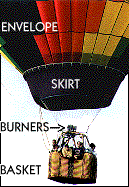 |
The heart of the balloon is the burner, usually rigged on a rigid brace over the pilotís head and controlled by means of a hand valve. Hot air balloons use plain old air as the lifting gas. By heating the air inside the balloon (with blasts from the burner), the pilot makes that air less dense (lighter) than the outside air, and the balloon rises. As the internal air cools, the balloon becomes heavier, and descends. |
Frequently Asked Questions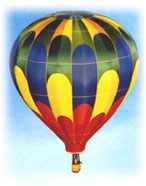 How do balloons fly?
How do balloons fly?Balloons operate through the basic principles of gravity and heat transfer. As the air inside the balloon is heated, it rises. As the air inside the balloon cools, it descends. To make the balloon fly, an inflator fan fills it with cool air, which is then heated. Can you steer a balloon? Winds and breezes determine a balloonís direction. Balloonists can steer a balloon, to a limited extent, by adjusting the balloonís altitude to make use of different wind speeds and directions. It is an artful selection of altitudes that accomplishes the steering of a balloon. 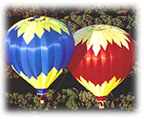 How long does a balloon flight last?
How long does a balloon flight last?The actual flight time averages about an hour. The entire ballooning experience, including pre-flight preparation, flight and post-flight celebration, may take two to three hours. What fuel do balloons use? Sport hot air balloons carry 20 to 45 gallons of propane in stainless steel and aluminum fuel tanks. Why do balloons fly in the early morning and late evening? Winds are generally most favorable the first hours after sunrise and the last hours before sunset. The sunís uneven heating of the earthís surface causes strong, variable winds. In the morning, it takes a few hours for the sun to heat the earthís surface enough to generate the thermal activity that creates wind. In the evening, the sunís intensity has diminished enough to reduce winds to acceptable flight levels in some areas of the country. Ideal winds are 3 to 6 mph. How high do balloons fly? Balloons typically fly from treetop level all the way up to several thousand feet, depending on what the pilot is trying to accomplish. The world record in a stock hot air balloon is over 32,000 feet! However most flights are between 500 and 2,500 feet above the ground. Who can be a balloonist? Balloon pilots come from all walks of life. Anyone with the desire to learn to fly a balloon can become a pilot. You can also become a Crew Member or even an Observer balloonist. Do you need a pilot's license? Yes. There are three levels of balloon pilot ratings. The first level is the student pilot, who gets from 10 to about 25 hours training with an instructor before getting the OK to test for the next level. The second level is a private pilot. The student pilot must pass a written test, an oral test and then an FAA flight check prior to being issued a private pilotís license. The third level of rating is a commercial pilot. The private pilot must have at least 35 hours of flight time and must pass additional written and oral tests and a more extensive FAA flight check prior to being issued a commercial pilot license. The holder of a commercial pilot license may operate a balloon for hire and may give flight instruction. How can I be involved without buying a balloon or becoming a pilot? Many people start in ballooning as a crew person. In most areas, you can join a local club that organizes races and community functions. You can also join the Balloon Federation of America, www.bfa.org, which is the national sanctioning body for National Championships and is dedicated to promotion of the sport. Or the next time you see a balloon flying in your area, follow it and offer to help when it lands. What equipment is required for balloons? Balloons include several parts: the envelope (the fabric portion of the balloon), the basket, burners and fuel systems. The material for balloon envelopes are made of ripstop nylon with tough, durable coatings for heat and air retention. The basket is made of wicker, which is strong, yet flexible and is aesthetically pleasing. Burners can come in either single, dual, or triple. How much does a balloon cost? Like cars and boats, new balloons can vary in size and amenities. You can start with a smaller sport model for around $15,000. These balloons typically carry a pilot and one additional person. The larger balloons that can carry two or three passengers in addition to the pilot will range between $20,000 and $40,000. Then there are the special shape balloons that are mostly custom made and can cost in the $50,000 to $250,000 range. If well maintained, a balloon envelope should last 500 or more flying hours. |
More History of Ballooning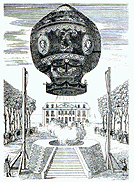 In 1960 the evolution of the
hot air balloon flared in one bright burst after 177 years of
virtually static advancement. Since brothers Joseph and Etienne
Montgolfier launched the first unmanned hot air balloon in France in
1783, comparatively little progress had been made in ballooning. But
that all changed in October of 1960 when some imaginative people
launched the first manned hot air balloon flight with a continuous
burner source and petroleum fuel -- the birth of the modern day
balloon system. In 1960 the evolution of the
hot air balloon flared in one bright burst after 177 years of
virtually static advancement. Since brothers Joseph and Etienne
Montgolfier launched the first unmanned hot air balloon in France in
1783, comparatively little progress had been made in ballooning. But
that all changed in October of 1960 when some imaginative people
launched the first manned hot air balloon flight with a continuous
burner source and petroleum fuel -- the birth of the modern day
balloon system.The curious, imaginative and creative people responsible for this metamorphosis in hot air ballooning were from a fledging company founded only four years earlier named Raven Industries. Located in Sioux Falls, South Dakota, Raven Industries was formed by a small group of aeronautical researchers who had all been working for a division of General Mills that was dedicated to the scientific balloon business. The primary purpose of the new company was to supply plastic products to the agricultural market. But the fascination and passion of ballooning compelled the founders to keep alive a second purpose: that of entering into the scientific balloon industry utilizing the imagination and innovation by which they would come to be defined. Initially, Raven Industriesí balloon business consisted of offering a free research balloon to the US Navy on a trial basis. That wild shot struck its mark and Raven Industries found itself producing a line of polyethylene high-altitude balloons used for research in the near space environment of 100,000 to 150,000 foot altitudes. Such high altitude balloons with capsules carrying mice, monkeys and even cosmic ray measuring devices served as a key proving ground for establishing manís compatibility in space. 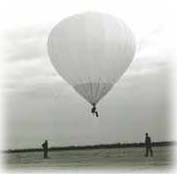 After 1960, with the revolution in hot air ballooning
having taken place, Raven engineers continued to single-handedly
create the cutting edge. Burner development, fuel supply, envelope
materials and flight characteristics were perpetually and
obsessively researched and designed. Which perhaps explains why the
hot air balloon basket didnít appear until 1963. In those early
years, the tug of war between man-controlling-the-balloon and the
balloon-controlling-man dominated the high spirited (and sometimes
hilarious) development of the modern hot air balloon. After 1960, with the revolution in hot air ballooning
having taken place, Raven engineers continued to single-handedly
create the cutting edge. Burner development, fuel supply, envelope
materials and flight characteristics were perpetually and
obsessively researched and designed. Which perhaps explains why the
hot air balloon basket didnít appear until 1963. In those early
years, the tug of war between man-controlling-the-balloon and the
balloon-controlling-man dominated the high spirited (and sometimes
hilarious) development of the modern hot air balloon. Early hot air balloon sales were made exclusively to the government for military and research applications. But by the mid 1960s some adventuresome folks outside of the ranks of Raven Industries employees began buying the balloons for recreation and sport. The potential of recreational ballooning seemed obvious, so Raven engineers set about meeting and, in many ways, defining conformance requirements for obtaining an FAA Type Certificate for a hot air balloon aircraft in 1968. From that moment through the mid 1970s a tremendous growth in private ballooning unfolded. 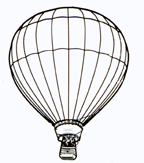 Hand in hand with this growth was an upswing in what
had already been continuous advancement in ballooning technology by
Raven engineers. Burner output grew exponentially to the point
where now "30,000,000 BTU" burners are the norm. The means
of deflation and maneuvering experienced dramatic progression. And the old-world craftsmanship of the beautiful and eminently practical wicker basket first established its omnipresence in ballooning at this time. Todayís
baskets remain traditional in their hand-woven wicker workmanship, but have advanced greatly in the multitude of models, colorful wicker accents, lush padded Cordura, and leather detailing are now available. Hand in hand with this growth was an upswing in what
had already been continuous advancement in ballooning technology by
Raven engineers. Burner output grew exponentially to the point
where now "30,000,000 BTU" burners are the norm. The means
of deflation and maneuvering experienced dramatic progression. And the old-world craftsmanship of the beautiful and eminently practical wicker basket first established its omnipresence in ballooning at this time. Todayís
baskets remain traditional in their hand-woven wicker workmanship, but have advanced greatly in the multitude of models, colorful wicker accents, lush padded Cordura, and leather detailing are now available. Ballooning and Raven both continued to expand through the end of the decade and on into the 1980s. When in 1980 Raven became the first South Dakota corporation to be listed on the American Stock Exchange, the company found itself growing more successful -- and more diverse. Made up of successful divisions producing everything from electronics to ski clothing (all of which were born from balloon research), Raven Industries chose to create a new wholly owned subsidiary titled Aerostar International, Inc. 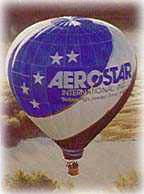 On February 1, 1986 Aerostar was born with the completed transfer of Raven Industriesí type certificates, production certificates and maintenance certificate. With their newfound, full-time focus on ballooning, the former employees of the Raven hot air balloon department enjoyed a freedom to concentrate completely on ballooning. The results over subsequent
years, while solidly in the Raven tradition of technological
advancement and esthetic changes, have arguably surpassed the pace
set by Raven while it invented an industry.
On February 1, 1986 Aerostar was born with the completed transfer of Raven Industriesí type certificates, production certificates and maintenance certificate. With their newfound, full-time focus on ballooning, the former employees of the Raven hot air balloon department enjoyed a freedom to concentrate completely on ballooning. The results over subsequent
years, while solidly in the Raven tradition of technological
advancement and esthetic changes, have arguably surpassed the pace
set by Raven while it invented an industry. The accomplishments and advancements have been continuous, diverse and so numerous it would be impossible to list them all. Examples, from the list run the entire gamut of the unique and enthralling business of building hot air balloons: Wireless instrumentation. Flexi-rigid upright systems, continued refinements in product testing, exclusive fabrics manufactured specifically for the rigorous application of ballooning, and taking the most complex ideas for special shape hot air balloons from the imagination of the sketch pad to the reality of the sky. The future of ballooning remains to be written, but we see only increased potential for technological advance, increased safety and enhanced enjoyment of ballooning. Aerostar International, supported by the tradition and resources of Raven Industries, looks to the next millennium -- and to the skies -- with an eagerness borne of experience, and a smile borne of the childlike wonder that flight has forever inspired. |